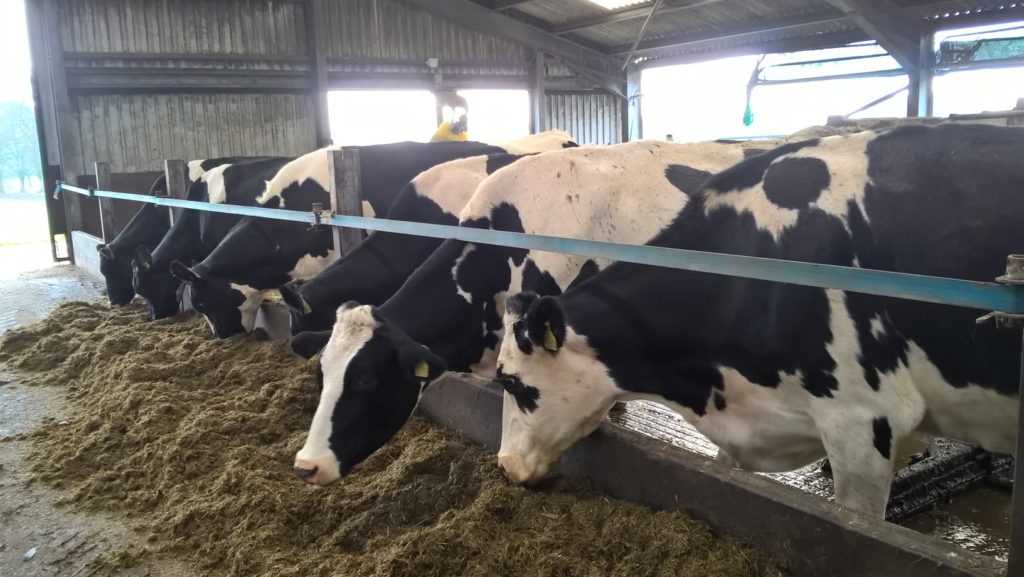Feed Space and Milk Output
9 June 2020The natural behaviour of cows is to synchronise certain habits so that the majority of animals in the herd feed, rest and ruminate at the same time. This natural behaviour can be restricted in housed systems, especially if there is competition for feed and lying space. Some animals may adapt their feeding times if space is limited, so as to avoid aggressive interactions at the feed fence. For example, during peak feeding times (after milking) subordinate animals will eat less and have fewer, larger feeds at other times. They may also be eating a ration of inferior quality if feed sorting is an issue. First lactation heifers tend to have different feeding behaviour to cows, having more frequent meals of a smaller size. Therefore, if feed space is limited, then the subordinate heifers will be the ones that lose out, ending up in poorer body condition than the cows.
Feed Space
A study providing cows with either 0.5m or 1m of feed space showed that with 1m, there were 57% fewer aggressive interactions between cows, increased spacing between cows at the feed fence (60% more) and greater feeding activity. After fresh feed was provided, in the subsequent 90 minutes, there was an increase of 24% in feeding activity and time spent feeding, which was more evident in subordinate animals (DeVries et al, 2004). Unfortunately, this research did not measure feed intake or milk yield between the 0.5m and 1.0m feed space groups. However, it is not unreasonable to assume that the cows with 1m feed space had a higher dry matter intake and therefore produce more milk.
Allowing cows the opportunity to eat little and often is more conducive to a stable rumen fermentation, better feed conversion efficiency, and more milk fat production. Recommendations are to provide a minimum of 2ft or 60cm feed space per cow but 75cm should be the target and slightly more for fresh cows and dry cows (between 85-100cm).
While it could be argued that feed space per cow is not so important in herds that are robotically milked, because there is not the peak feeding time associated after milking through the parlour, it can still have a positive influence. Deming et al, 2013, found that for every 10cm/cow increase in space at the feed fence, there was a 1.7kg/day increase in daily milk yield per cow in a robotic system.
Available lying space also affects milk output. When a cow is lying down, there is 30% more blood circulating through the udder than when she is standing up. The more opportunities cows have to lie down, the more milk they make. A general rule of thumb is an extra 1 litre of milk per extra hour increase in lying time, with the target lying time being 12 hours/day. A paper published in the USA reported that for every 10% increase in stocking rate above 80% occupancy, there is reduction of 0.73kg milk/cow/day (Cook and Norlund, 2004). The aim is to have at least 5% more cubicles than cow numbers.
Milk Output
Some dairy farmers have recently had to reduce milk output in April and May at the request of their processor and many complied by drying off cows early and culling harder, reducing milking cow numbers. In some cases, there have been reports of herds actually maintaining or even increasing milk output, indicating that facilities were overstocked in the first place and that the additional feed and/or lying space has benefited milk production. Not only will this have benefited profitability (reducing feed costs in relation to milk output), there is also a positive effect on carbon footprint, with more litres of milk being produced from less cows.
The UK has had some warm weather over the last two months, and it is also possible that housed herds may have experienced a degree of heat stress, especially those housed in older buildings with poorer ventilation and high humidity. With less cows in the shed, any impact of heat stress may have been reduced, again benefiting production.
For dairy farmers that reduced the size of the milking herd to reduce milk output but saw no drop in production, we are keen to know why you think this response has occurred. We would be extremely grateful therefore if you could fill in a very short questionnaire which is available online at: https://forms.office.com/Pages/ResponsePage.aspx?id=mC1UyEzmbkS41QyY_-VlJu2d1mcaAoNNu1KZSaSFiHBUNlYzRkZLMkNYTklPUjhPTE4zNjVUQzkyRS4u
Reference available upon request.
Lorna MacPherson lorna.macpherson@sac.co.uk
Sign up to the FAS newsletter
Receive updates on news, events and publications from Scotland’s Farm Advisory Service

